NCERT Exemplar Class 12 Chemistry Chapter 8 The d- and f-Block Elements are part of NCERT Exemplar Class 12 Chemistry . Here we have given NCERT Exemplar Class 12 Chemistry Chapter 8 The d- and f-Block Elements.
NCERT Exemplar Class 12 Chemistry Chapter 8 The d- and f-Block Elements
Multiple Choice Questions
Single Correct Answer Type
Question 1. Electronic configuration of a transition element X in +3 oxidation state is [Ar] 3d
5
. What is its atomic number?
(a) 25 (b) 26 (c) 27 (d) 24
Solution:

Question 2. The electronic configuration of Cu(II) is 3d
9
whereas that of Cu(I) is 3d
10
. Which of the following is correct?
(a) Cu(II) is more stable .
(b) Cu(II) is less stable
(c) Cu(I) and Cu(II) are equally stable
(d) Stability of Cu(I) and Cu(I) depends on nature of copper salts.
Solution:
(a) Cu(II) is more stable due to greater effective nuclear charge of Cu(II).
Question 3. Metallic radii of some transition elements are given below. Which of these elements will have highest density?

Solution:
(d) On moving left to right along period, metallic radius decreases while mass increases. Decreases in metallic radius coupled with increase in atomic mass results in increase in density of metal.
Hence, among the given four choices Cu belongs to right side of Periodic Table in transition metal, and it has the highest density (89 g/cm3).
Question 4. Generally, transition elements form coloured salts due to the presence of unpaired electrons. Which of the following compound will be coloured in solid state?
(a) Ag
2
SO
4
(b) CUF
2
(c) ZnF
2
(d) Cu
2
Cl
2
Solution:
(b) Cu
2+
has 1 unpaired electron in CuF
2
, hence, it is coloured in solid state.
Question 5. On addition of small amount of KMnO
4
to concentrated H
2
SO
4
, a green oily compound is obtained which is highly explosive in nature. Identify the compound from the following:
(a) Mn
2
O
7
(b) MnO
2
(c) MnSO
4
(d) Mn
2
O
3
Solution:
(a) 2KMn
O
4
+ 2H
2
S
O
4
(Conc ) –> Mn
2
O
7
+ 2KHS
O
4
+ H
2
O
Question 6. The magnetic nature of elements depend on the presence of unpaired electrons. Identify the configuration of transition element, which shows the highest magnetic moment.
(a) 3d
7
(b) 3d
5
(c) 3d
8
(d) 3d
2
Solution:
(b) The greater the number of unpaired electron, the higher will be its value of magnetic moment. Since, 3d
5
has 5 unpaired electrons hence highest magnetic moment.

Question 7. Which of the following oxidation state is common for all lanthanoids?
(a) +2 (b) +3 (c) +4 (d) +5
Solution:
(b) +3 oxidation state is most common for all lanthanoids.
Question 8. Which of the following reactions are disproportionation reactions?
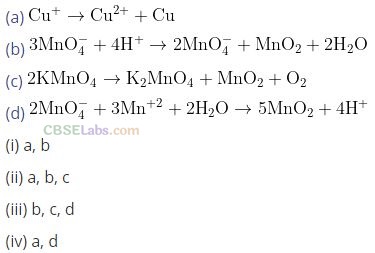
Solution:

Question 9. When KMnO
4
solution is added to oxalic acid solution, the decolourisation is slow in the beginning but becomes instantaneous after some time because
(a) CO
2
is formed as the product (b) Reaction is exothermic
(c) Mn04 catalyses the reaction (d) Mn
2+
acts as autocatalyst
Solution:
(d) When KMn
O
4
solution is added to oxalic acid solution, the decolourisation is slow in the beginning but becomes instantaneous after some time because Mn2+ acts as an autocatalyst.


Question 10. There are 14 elements in actinoid series. Which of the following element does-not belong to this series?
(a) U (b) Np (c) Tm (d) Fm
Solution:
(c) Tm (Thulium) is a lanthanoid.
Question 11. KMnO
4
acts as an oxidizing agent in acidic medium. The number of moles of KMn04 that will be needed to react with one mole of sulphide ions in acidic solution is

Solution:

Question 12. Which of the following is amphoteric oxide?
Mn
2
O
7
, CrO
3
, Cr
2
O
3
, CrO, V
2
O
5
, V
2
O
4
(a) V
2
O
5
, Cr
2
O
3
(b)Mn
2
O
7
, CrO
3
(c) CrO, V
2
O
5
(d) V
2
O
5
, V
2
O
4
Solution:
(a) V
2
O
5
and Cr
2
O
3
are amphoteric oxides because both react with alkalies as well as acids.
Remember: In lower oxides, the basic character is predominant while in higher oxides, the acidic character is predominant.
Question 13. Gadolinium belongs to 4f series. Its atomic number is 64. Which of the following is the correct electronic configuration of gadolinium?

Solution:
(a) 64Gd: [Xe] 4f7 5d1 6s2
Question 14. Interstitial compounds are formed when small atoms are trapped inside the crystal lattice of metals. Which of the following is not the characteristic property of interstitial compounds?
(a) They have high melting points in comparison to pure metals
(b) They are very hard
(c) They retain metallic conductivity
(d) They are chemically very reactive.
Solution:
(d) Interstitial compounds are chemically inert.
Question 15. The magnetic moment is associated with its spin angular momentum and orbital angular momentum. Spin only magnetic moment value of Cr
3+
ion is
(a) 2.87 B.M. (b) 3.87 B.M. (c) 3.47 B.M. (d) 3.57 B.M.
Solution:
(b) The magnetic moment is associated with its spin angular momentum and orbital angular momentum.

Question 16. KMn04 acts as an oxidizing agent in alkaline medium. When alkaline KMnO
4
is treated with KI, iodide ion is oxidized to
(a) I
2
(b)Io
–
(c) I0
3
(d) I0
4
Solution:
(c) 2KMnO
4
+ KI + H
2
O –> 2K0H + 2MnO
2
+ KI0
3
Question 17. Which of the following statement is not correct?
(a) Copper liberates hydrogen from acids
(b) In its higher oxidation states, manganese forms stable compounds with oxygen and fluorine
(c) Mn
3+
and Co
3+
are oxidizing agents in aqueous solution
(d) Ti
2+
and Cr
2+
are reducing agents in aqueous solution
Solution:
(a) Copper does not liberate hydrogen from acids.
Cu + 2H2S0
4
–> CuSO
4
+ S0
2
+ 2H
2
O
3Cu + 8HNO
3
–> 3CU(N0
3
)
2
+ 2NO + 4H
2
O
Question 18. When acidified K
2
Cr
2
O
7
solution is added to Sn
2+
salts, Sn
2+
changes to
(a) Sn (b) Sn
3+
(c) Sn
4+
(d) Sn
+
Solution:
(c) When acidified K
2
Cr
2
O
7
solution is added to Sn
2+
salt, Sn
2+
changes to Sn
4+
.
The reaction is given below

Question 19. Highest oxidation state of manganese in fluoride is +4 (MnF
4
) but highest
oxidation state in oxides is +7 (Mn
2
O
7
) because
(a) fluorine is more electronegative than oxygen
(b) fluorine does not possess d-orbitals
(c) fluorine stabilizes lower oxidation state
(d) in covalent compounds fluorine can form single bond only while oxygen forms double bond
Solution:
(d) The highest oxidation state of manganese in fluoride is +4 (MnF
4
) but in oxides it is +7 (Mn
2
O
7
) because in covalent compounds fluorine can form single bond only while oxygen forms double bond.
Question 20. Although zirconium belongs to 4d transition series and hafnium to 5d
transition series even then they show similar physical and chemical properties because
(a) both belong to d-block
(b) both have same number of electrons
(c) both have similar atomic radius
(d) both belong to the same group of the periodic table
Solution:
(c) Zirconium and hafnium have similar atomic radius hence they show similar physical and chemical properties.
Question 21. Why is HCl not used to make the medium acidic in oxidation reactions of KMnO
4
in acidic medium?
(a) Both HCl and KMn0
4
act as oxidizing agents.
(b) KMnO
4
oxidises HCl into Cl
2
which is also an oxidizing agent.
(c) KMnO
4
is a weaker oxidizing agent than HCl.
(d) KMnO
4
acts as a reducing agent in the presence of HCl.
Solution:
(b) HCl is not used to make the medium acidic in oxidation reactions of KMnO
4
in acidic medium. The reason is that if HCl is used, the oxygen produced from KMnO
4
+ HCl is partly utilized in oxidizing HCl to Cl, which itself acts as an oxidizing agent and partly oxidises the reducing agent.
More than One Correct Answer Type
Question 22. Generally, transition-elements and their salts are coloured due to the presence of unpaired electrons in metal ions. Which of the following compounds are coloured?
(a) kMnO
4
(b) Ce(SO
4
)
2
(c) TiCl
4
(d) Cu
2
Cl
2
Solution:
(a, b) KMnO
4
and Ce(S0
4
)
2
are coloured due to charge transfer.
Question 23. Transition elements show magnetic moment due to spin and orbital motion of electrons. Which of the following metallic ions have almost same spin only magnetic moment?
(a) Co
2+
(b) Cr
2+
(c) Mn
2+
(d) Cr
3+
Solution:
(a, d) Co
2+
(3d
7
) and Cr
3+
(3d
3
) have 3 unpaired electrons. Hence they have almost same spin only magnetic moment.
Question 24. In the form of dichromate, Cr (VI) is a strong oxidizing agent in acidic medium
but Mo (VI) in MoO
3
and W (VI) in WO
3
are not because
(a) Cr (VI) is more stable than Mo(VI) and W(VI)
(b) Mo(VI) and W(VI) are more stable than Cr(VI)
(c) higher oxidation states of heavier members of group-6 of transition series are more stable
(d) lower oxidation states of heavier members of group-6 of transition series are more stable
Solution:
(b, c) In d-block elements, for heavier elements, the higher oxidation states are more stable. Hence, Mo(VI) and W(VI) are more stable than Cr (VI). That’s why, Cr (VI) in the form of dichromate is a stronger oxidizing agent in acidic medium whereas Mo03 and W03 are not.
Question 25. Which of the following actinoids show oxidation states up to +7?
(a) Am (b) Pu (c) U (d) Np
Solution:
(b, d) Np and Pu show +7 oxidation state.
Question 26. General electronic configuration of actinoids is (n – 2)f
1-14
(n – 1 )d
0-2
ns
2
. Which of the following actinoids have one electron in 6d orbital?
(a) U (Atomic no. 92) (b) Np (Atomic no. 93)
(c) Pu (Atomic no. 94) (d) Am (Atomic no. 95)
Solution:

Question 27. Which of the following lanthanoids show +2 oxidation state besides the characteristic oxidation state +3 of lanthanoids?
(a) Ce (b) Eu (c) Yb (d) Ho
Solution:
(b, c)
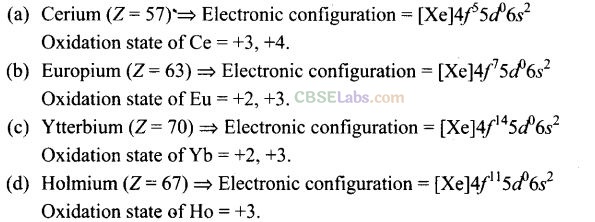
Question 28. Which of the following ions show higher spin only magnetic moment value?
(a) Ti
3+
(b) Mn
2+
(c) Fe
2+
(d) Co
3+
Solution:
(b, c) Mn
2+
(3d
5
) and Fe
2+
(3d
6
) have 5 and 4 unpaired electrons hence higher values of spin only magnetic moment as compared to Ti
3+
(3d
1
) and Co
2+
(3d
7
).
Question 29. Transition elements form binary compounds with halogens. Which of the following elements will form MF3 type compounds?
(a) Cr (b) Co (c) Cu (d) Ni
Solution:
(a, b) Cr and Co form MF
3
type of compounds. The ability of fluorine to stabilize the highest oxidation state is due to higher lattice energy in CoF
3
and higher bond enthalpy for the higher covalent compound like CrF
6
.
Question 30. Which of the following will not act as oxidizing agents?
(a) CrO
3
(b) MoO
3
(c) WO
3
(d) CrO
4
2-
Solution:
(b, c) A species can act as an oxidizing agent only when metal is present in high oxidation state but lower oxidation state show stability. As higher oxidations states of W and Mo are more stable, therefore they will not act as oxidizing agents.
Question 31. Although +3 is the characteristic oxidation state for lanthanoids but cerium
also shows +4 oxidation state because
(a) it has variable ionization enthalpy
(b) it has a tendency to attain noble gas configuration
(c) it has a tendency to attain f° configuration
(d) it resembles Pb
4+
Solution:
(b, c) Cerium shows +4 oxidation state also because it has a tendency to attain noble gas configuration and attain f° configuration.
Ce – 4f
1
5d’6s
2
(Ce
4+
– 4f°)
Short Answer Type Questions
Question 32. Why does copper not replace hydrogen from acids?
Solution:
The value of standard reduction potential of copper (E° = +0.34 V) is positive. Therefore, copper does not liberate hydrogen from acids.
Question 33. Why E° value for Mn, Ni and Zn are more negative than expected?
Solution:
Negative E° values of Mn
2+
and Zn
2+
are because of stabilities of half-filled (3d
10
: Mn
2+
) and fully-filled (3d
10
: Zn
2+
) configuration respectively.Mn
2+
ion has higher E° value because of highest negative enthalpy of hydrogen.
Question 34. Why first ionization enthalpy of Cr is lower than that of Zn?
Solution:
The electronic configuration of chromium and zinc are respectively:
Cr (24) = [Ar] 3d
5
4s
2
Zn (30) = [Ar] 3d
10
4s
2
It is easy to remove electron from 4s
1
-orbital (unpaired) rather than from 4s
2
-orbital (paired).
Question 35. Transition elements show high melting points. Why?
Solution:
The high melting points of transition metals are due to strong metallic bonds between the atoms of these elements. This is because of involvements of greater number of electrons in the interatomic metallic bonding from (n – 1) d orbitals in addition to ns electrons.
Question 36. When Cu
2+
ion is treated with KI, a white precipitate is formed. Explain the reaction with the help of chemical equation.
Solution:
Reduction of Cu
2+
to Cu
+
takes place due to reaction with F ions. This is given by the equation.

Question 37. Out of Cu
2
Cl
2
and CuCl
2
, which is more stable and why?
Solution:
CuCl
2
is more stable than Cu
2
Cl
2
. The stability of CuCl
2
is because of high enthalpy of hydration of Cu
2+
(aq) than that of Cu
+
(aq).
Question 38. When a brown compound of manganese
(A) is treated with HCl, it gives a gas
(B) The gas taken in excess, reacts with NH3 to give an explosive compound
(C) Identify compounds A, B and C.
Solution:
The compounds A, B and C are as follows:

Question 39. Although fluorine is more electronegative than oxygen, but the ability of oxygen to stabilize higher oxidation states exceeds that of fluorine. Why?
Solution:
The electronic configuration of fluorine is 1s
2
2s
2
2p
5
. Thus it can form only one bond as it has only one unpaired electron. Electronic configuration of oxygen is 1s
2
2s
2
2p
6
3s
2
3p
6
.
It may be mentioned that oxygen also has vacant d-orbitals along with two 3p orbitals containing single electron. Thus, oxygen has greater bond formation capacity. In other words, it has greater ability to stabilize higher oxidation states.
Question 40. Although Cr
3+
and CO
2+
ions have same number of unpaired electrons but the magnetic moment of Cr
3+
is 3.87 BM and that of CO
2+
is 4.87 BM. Why?
Solution:
The electronic configuration of Cr
3+
and CO
2+
ions are:
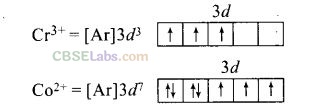
Due to symmetrical electronic configuration, there is no orbital contribution in Cr
3+
ion. However, appreciable contribution occurs in CO
2+
ion.
Question 41. Ionisation enthalpies of Ce. Pr and Nd are higher than Th, Pa and U. Why?
Solution:
It is because in the beginning when 5f-orbitals begin to be occupied, they
penetrate less into inner core electrons. Thus, 5f-electrons are more effectively shielded from the nuclear charge than 4f electrons in the lanthanide series. Therefore, outer electrons are less firmly held and thus these electrons are available for bonding in actinoids and their removal is much more easier. On account of this, the ionisation enthalpies of Th, Pa and U are comparatively lower than Ce, Pr and Nd.
Question 42. Although Zr belongs to 4d and Hf belongs to 5d transition series but it is quite difficult to separate them. Why?
Solution:
Zr, a member of Ad series and Hf, a member of 5d series, belong to same group. They are chemically so similar that their separation is difficult. This is due to the fact that both have same size due to lanthanide contraction. The radii of these elements are 160 pm (Zr) and 159 pm (Hf).
Question 43. Although +3 oxidation states is the characteristic oxidation state of lanthanoids but cerium shows +4 oxidation state also. Why?
Solution:
The electronic configuration of Ce is -4f
1
5d
1
6s
2
. Usually 5d’ and 6s
2
electrons are lost by the lanthanoids in their reactions i.e., they exhibit +3 oxidation states. But Ce exhibit +4 oxidation state also because it gains extra stability by losing 4f
1
electron because it will give rise to completely filled orbitals.
Question 44. Explain why does colour of KMnO
4
disappear when oxalic acid is added to its solution in acidic medium?
Solution:
The acidified solution of KMnO
4
acts as an oxidising agent. It oxidises oxalic acid into CO
2
and itself changes to Mn
2+
ion which is colourless.

Question 45. When orange solution containing Cr
2
O
7
2-
ion is treated with an alkali, a yellow solution is formed and when H
+
ions are added to yellow solution, an orange solution is obtained. Explain why does this happen?
Solution:
On heating with alkalies, the orange colour of dichromate solution changes to yellow due to the formation of chromate ions.
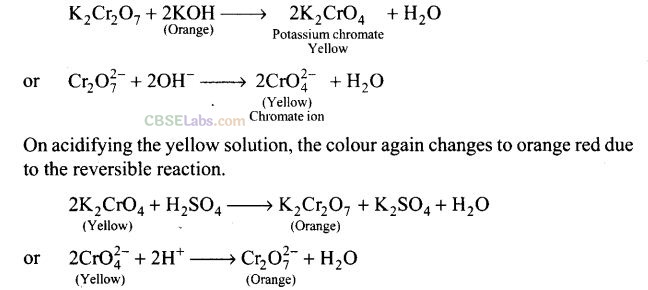
Question 46. A solution of KMnO
4
on reduction yields either a colourless solution or a brown precipitate or a green solution depending on pH of the solution. What different stages of the reduction do these represent and how are they carried out?
Solution:
KMnO
4
acts as an oxidising agent in alkaline, neutral and acidic mediums, i.e., oxidising behaviour of KMnO
4
depends on pH of the solution.
In alkaline medium (pH > 7),
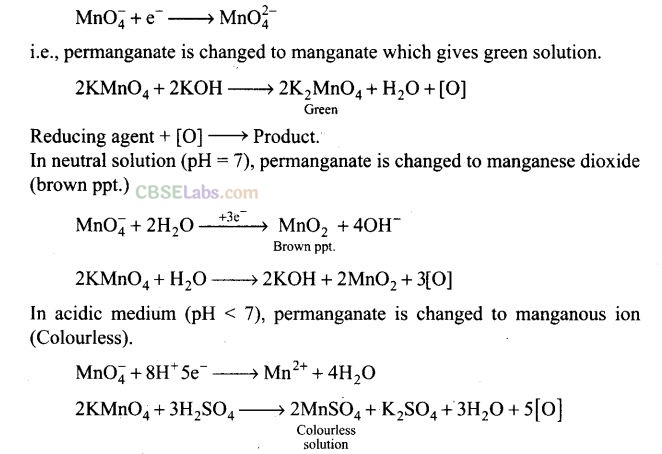
Question 47. The second and third rows of tfansition elements resemble each other much more than they resemble the first row. Explain why?
Solution:
Due to lanthanide contraction, the atomic radii of the second and third row transition elements are almost same. Therefore, they resemble each other much more as compared to first row elements.
Question 48. E of Cu is +0.34 V while that of Zn is -0.76 V. Explain.
Solution:
High ionisation enthalpy to change Cu(s) to Cu
2+
is not balanced by hydration enthalpy. Therefore, it exhibits a positive E° value. However, Zn exhibits a lower value of ionization enthalpy because a stable 3d
10
configuration is attained after losing two electrons. The hydration energy for Zn
2+
is comparable to that ofCu
2+
. Therefore, E° for Zn is negative.
Question 49. The halides of transition elements become more covalent with increasing oxidation state of the metal. Why?
Solution:
As the oxidation state of the element increases, its charge increases. According to Fajans rules, as the charge of the metal ion increases covalent character increases because the positively charged cation attracts the electron cloud on the anion towards itself.
Question 50. While filling up of electrons in the atomic orbitals, the 4s orbital is filled before the 3d-orbital but reverse happens during the ionization of the atom. Explain why?
Solution:
According to n +l rule: For 3d=n + l = 5
4s = n + l = 4
Therefore, the electron will enter in 4s orbital first and then in 3d orbitals. Ionisation enthalpy is responsible for the ionisation of atom. 4s electrons are loosely held by the nucleus. So electrons are removed from 4s orbital prior to 3d.
Question 51. Reactivity of transition elements decreases almost regularly from Sc to Cu. Explain.
Solution:
Reactivity of an element is dependent on the value of ionization enthalpy. In moving from Sc, the first element to Cu, the ionization enthalpy increases regularly. Therefore, the reactivity degreases as we move from Sc to Cu.
Matching Column Type Questions
Question 52. Match the catalysts given in Column I with the processes given in Column II.
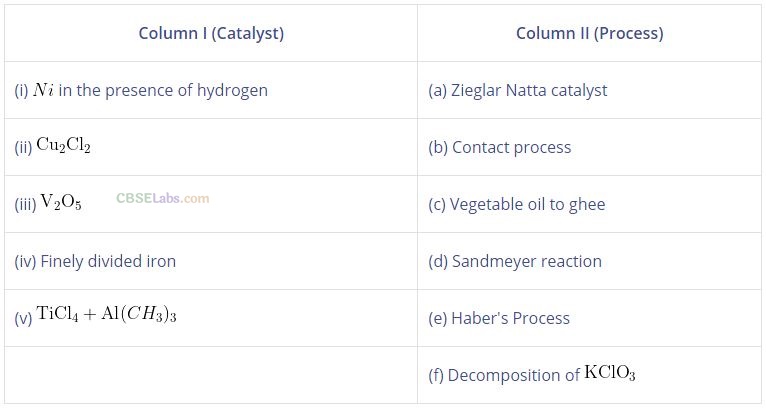
Solution:
(i—> c), (ii —> d), (iii —>b), (iv—> e), (v —> a)
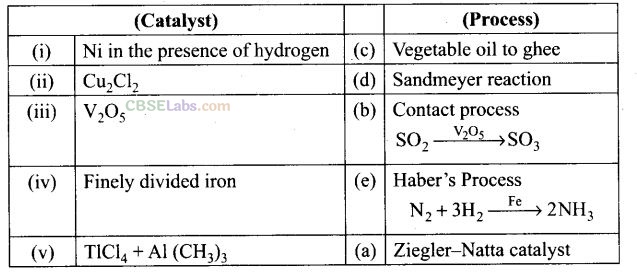
Question 53. Match the compounds/elements given in Column I with uses given in Column II.
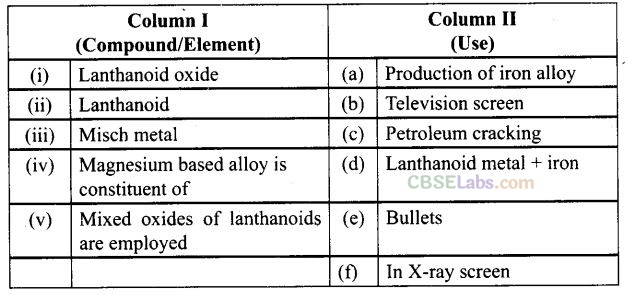
Solution:
(i —> b), (ii —> a), (iii —> d), (iv e), (v—> c)
Question 54. Match the properties given in Column I with the metals given in Column II.
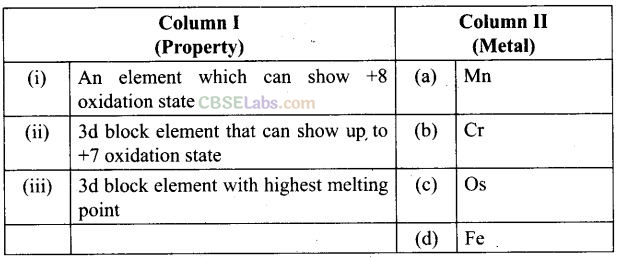
Solution:
(i —> c), (ii —> a), (iii —>b)
(i) Osmium is an element which show +8 oxidation state.
(ii) 3d block element that can show up to +7 oxidation state is manganese.
(iii) 3d block element with highest melting point is chromium.
Question 55. Match the statements given in Column I with the oxidation states given in Column II.

Solution:
(i —> c), (ii —> a), (iii —> e), (iv —> b)
Question 56.Match the statements given in Column I with the Colours given in Column II.
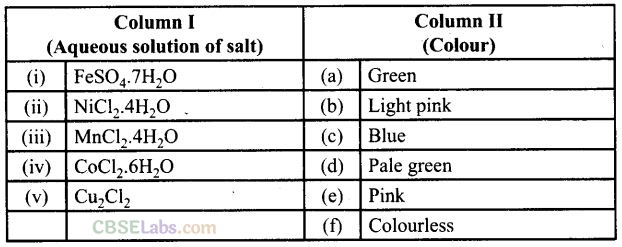
Solution:
(i —> d), (ii —>a), (iii —> b), (iv—> e), (v —>f)
Question 57. Match the property given in Column I with the element given in Column II.
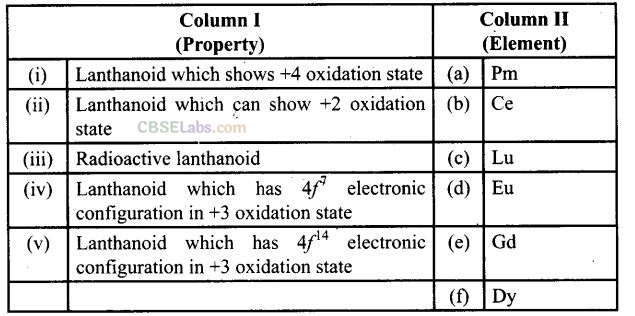
Solution:
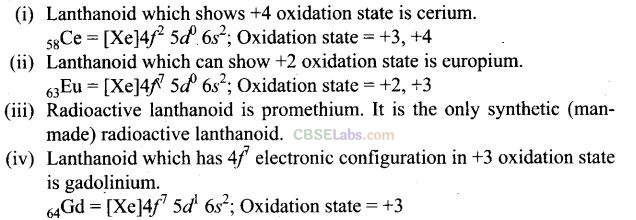
Question 58. Match the properties given in Column I with the metals given in Column II.
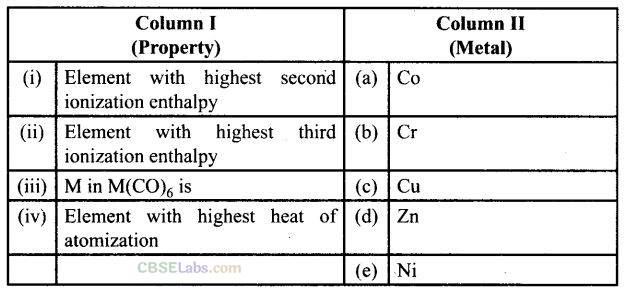
Solution:
(i —> c), (ii —> d), (iii —>b), (iv—> e)

Assertion and Reason Type Questions
In the following questions, a statement of Assertion (A) followed by a statement of Reason (R) is given. Choose the correct answer out of the following choices:
(a) Both Assertion and Reason are true and the Reason is the correct explanation of Assertion.
(b) Both Assertion and Reason are true and the Reason is not the correct explanation of Assertion.
(c) Assertion is not true but the Reason is true.
(d) Both Assertion and Reason are false.
Question 59. Assertion (A): Cu
2+
iodide is not known.
Reason (R): Cu
2+
oxidises I to iodine.
Solution:
(a)
Cu
2+
oxidises iodide to iodine hence cupric iodide is converted to cuprous iodide.
Question 60. Assertion (A): Separation of Zr and Hf is difficult.
Reason (R): Because Zr and Hf lie in the same group of the periodic table.
Solution:
(b) Separation of Zr and Hf is difficult as both have same size.
Question 61. Assertion (A): Actinoids form relatively less stable complexes as compared to lanthanoids.
Reason (R): Actinoids can utilize their 5d orbitals along with 6d orbitals in bonding but lanthanoids do not use their 4f orbital for bonding.
Solution:
(c) Actinoids are more reactive and show greater range of oxidation states.
Question 62. Assertion (A): Cu can not libirate hydrogen from acids .
Reason (R): because it has positive electrode potential.
Solution:
(a) Cu can not libirate hydrogen from acides due to positive electrode potential.
Question 63. Assertion (A): The highest oxidation state of osmium is +8.
Reason (R): Osmium is a 5d-block element.
Solution:
(b) The highest oxidation state of osmium is +8 due to its ability to expand their octet by using its all 8 electrons.
Long Answer Type Questions
Question 64. Identify A to E and expain reaction involves
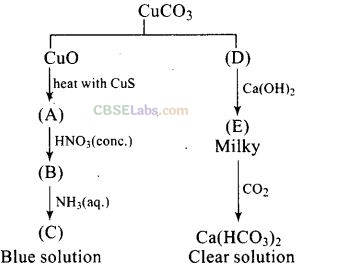
Solution:
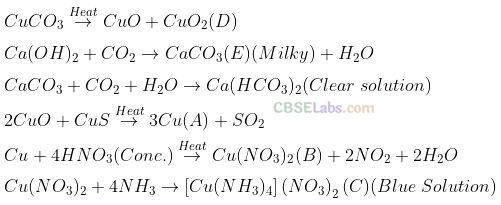
Question 65. When a chromite ore (A) is fused with sodium carbonate in free excess of air and the product is dissolved in water, a yellow solution of compound (B) is obtained. After treatment of this yellow solution with sulphuric acid, compound (C) can be crystallized from the solution. When compound (C) is treated with KCl, orange crystals of compound (D) crystallise out. Identify A to D and also explain the reactions.
Solution:
The compounds A, B, C and D are given as under:
![]()

Question 66. When an oxide of manganese (A) is fused with KOH in the presence of an oxidizing agent and dissolved in water, it gives a dark green solution of compound (B). Compound (B) disproportionates in neutral or acidic solution to give purple compound (C). An alkaline solution of compound (C) oxidises potassium iodide solution to a compound (D) and compound (A) is also formed. Identify compounds A to D and also explain the reactions involved.
Solution:
The compounds (A), (B), (C) and (D) are given as under:

Question 67. On the basis of lanthanoid contraction, explain the following:
(a) Nature of bonding in La
2
O
3
and Lu
2
O
3
.
(b) Trends in the stability of oxo-salts of lanthanoids from La to Lu.
(c) Stability of the complexes of lanthanoids.
(d) Radii of Ad- and 5d-block elements.
(e) Trends in acidic character of lanthanoid oxides.
Solution:
(a) Due to lanthanide contraction the size of the atom decreases with the decrease in size, the covalent character increases. Therefore, La
2
O
3
is more ionic while Lu
2
O
3
is mo.re covalent in nature.
(b) As the size decreases from La to Lu, the stability of the oxo-salts also decreases.
(c) Stability of complexes from La to Lu, increases as the size of the central atom decreases.
(d) Radii of the elements of Ad- and 5d-blocks in the same vertical columns are nearly the same.
(e) The acidic nature of lanthanoid oxides increases from La to Lu.
Question 68. (a) Answer the following questions:
(i) Which element of the first transition series has highest second ionization enthalpy?
(ii) Which element of the first transition series has highest third ionization enthalpy?
(iii) Which element of the first transition series has lowest enthalpy of atomization?
(b) Identify the metal and justify your answer:
(i) Carbonyl M(CO)
5
(ii) MO
3
F
Solution:
(a) (i) Cu, because the electronic configuration of Cu is 3d
10
4s
1
. So second
electron needs to be removed from completely filled tf-orbital.
(ii) Zn. The electronic configuration of Zn is 3d
10
4s
2
. The third electron needs to be removed from completely filled d-orbital.
(iii) Zn. There is no unpaired electron in Zn for metallic bonding.
(b) (i) Fe(CO)
5
as per EAN rule.
(ii) Mn03F. Mn shows +7 oxidation state; d-electrons are not involved in bonding.
Question 69.Mention the type of compounds formed when small atoms like H, C and N get trapped inside the crystal lattice of transition metals. Also give physical and chemical characteristics of these compounds.
Solution:
Compounds formed when small atoms like H, C and N get trapped inside the crystal lattice of transition metals are called interstitial compounds. Properties of such compounds are:
(i) High melting points higher than those of pure metals.
(ii) These compounds are very hard.
(iii) They retain metallic conductivity.
(iv) They are chemically inert.
Question 70. (a) Transition metals can act as catalysts because these can change their oxidation state.
How does Fe(III) catalyse the reaction between iodide and persulphate ions?
(b) Mention any three processes where transition metals act as catalysts.
Solution:
(a) Reaction between iodide and persulphate ions is:
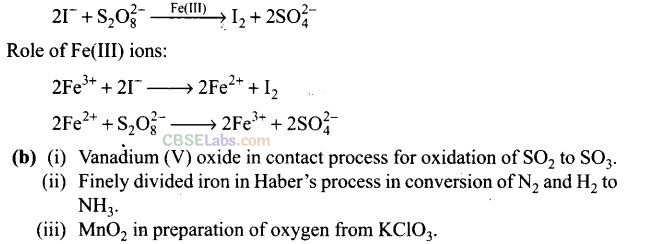
Question 71. A violet compound of manganese (A) decomposes on heating to liberate oxygen and compounds (B) and (C) of manganese are formed. Compound (C) reacts with KOH in the presence of potassium nitrate to give compound (B). On heating compound (C) with cone. H
2
SO
4
and NaCl, chlorine gas is liberated and a compound (D) of manganese along with other products is formed. Identify compounds A to D and also explain the reactions involved.
Solution:
The compounds A, B, C and D are given as under:
![]()

NCERT Exemplar Class 12 Chemistry Solutions
- Chapter 1 Solid State
- Chapter 2 Solution
- Chapter 3 Electrochemistry
- Chapter 4 Chemical Kinetics
- Chapter 5 Surface Chemistry
- Chapter 6 General Principles and Processes of Isolation of Elements
- Chapter 7 The p-Block Elements
- Chapter 8 The d- and f-Block Elements
- Chapter 9 Coordination Compounds
- Chapter 10 Haloalkanes and Haloarenes
- Chapter 11 Alcohols, Phenols and Ethers
- Chapter 12 Aldehydes, Ketones and Carboxylic Acids
- Chapter 13 Amines
- Chapter 14 Biomolecules
- Chapter 15 Polymers
- Chapter 16 Chemistry in Everyday Life